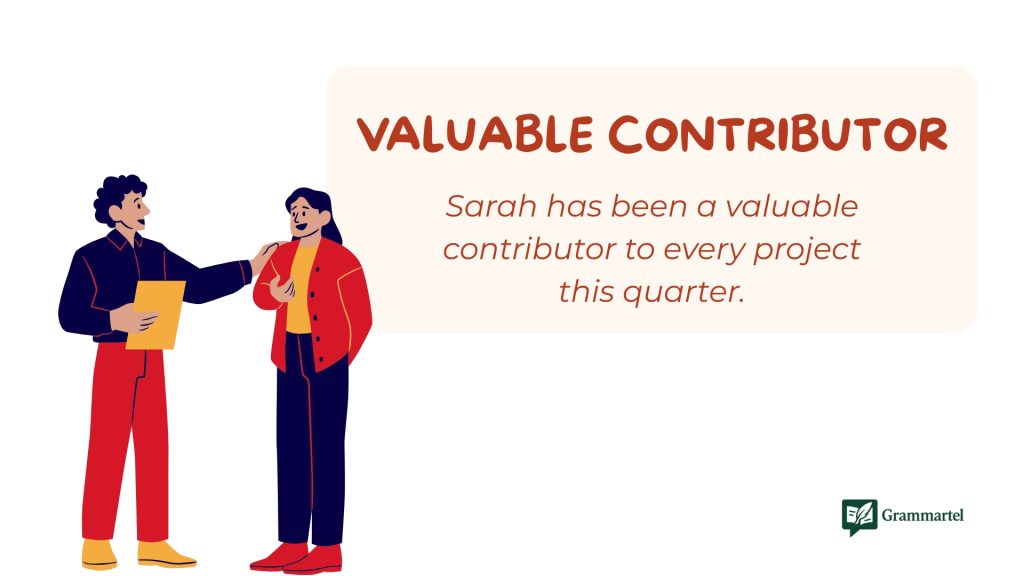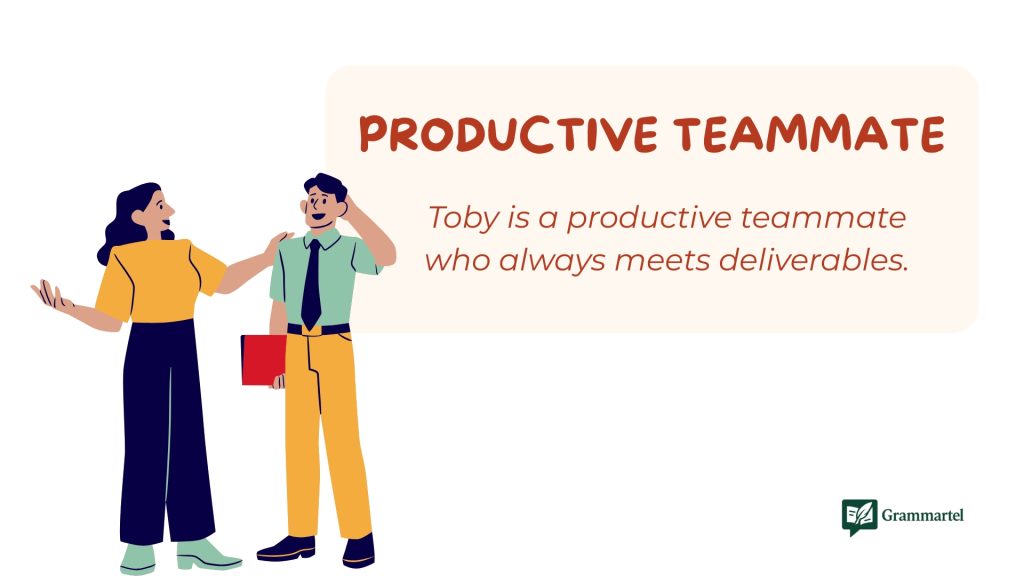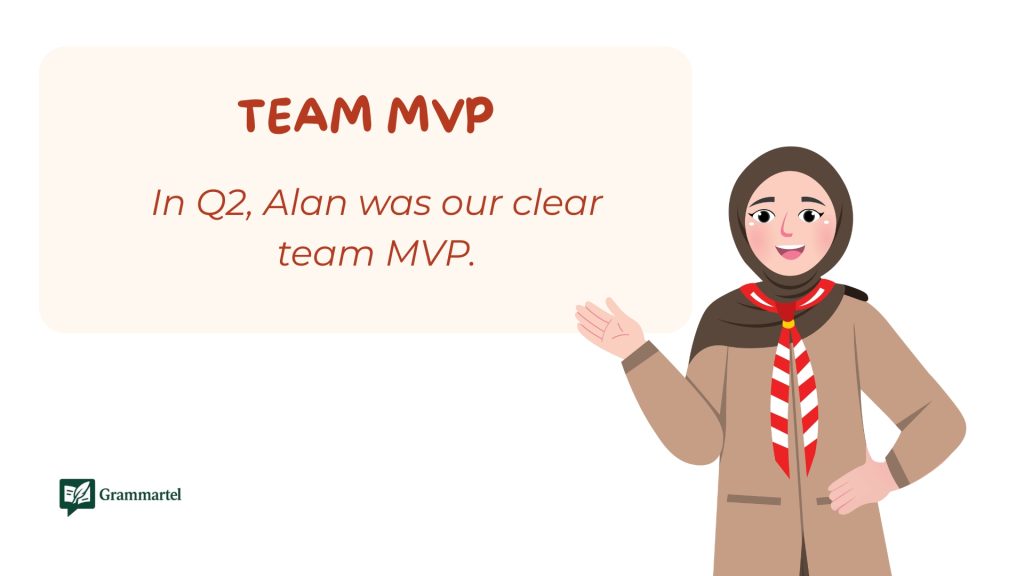Saying someone is a “great asset to the team” is a classic compliment—but let’s be honest, it’s also a bit overused. Whether you’re writing a reference, giving feedback, or just saying thanks, switching up your wording can make your message feel more thoughtful and sincere. There are plenty of fresh, meaningful ways to express appreciation for someone’s hard work, support, or team spirit. From casual praise to professional notes, a well-chosen phrase can go a long way. So if you’re tired of saying the same thing every time, we’ve got 40 better ways to say it—plus examples to help you out.
What Does “Great Asset to the Team” Mean?
“Great asset to the team” means someone helps the team a lot. This person adds value. They work hard, support others, and help reach goals. They may have special skills or a great attitude. The team is better because they are part of it.
When to Use “Great Asset to the Team”
Use this phrase when you want to praise someone. You can say it in job reviews, emails, or thank-you notes. It fits when someone makes a strong, positive impact. It’s good for coworkers, team leads, or anyone who helps the group succeed.
40 Better Ways to Say “Great Asset to the Team”
1. Valuable Contributor

Meaning: Someone who brings significant value to team outcomes.
Explanation: Highlights the impact and usefulness of the individual’s work.
Example: “Sarah has been a valuable contributor to every project this quarter.”
Best Use: Formal team evaluations or recommendation letters.
Worst Use: When trying to emphasize leadership rather than contribution.
Tone: Professional, appreciative
2. Key Team Player
Meaning: Someone whose role is integral to the team’s success.
Explanation: Suggests that the individual is essential to operations.
Example: “Jacob is a key team player in our product development team.”
Best Use: In performance reviews or executive summaries.
Worst Use: When the person works mostly independently.
Tone: Formal, strategic
3. Cornerstone of the Team
Meaning: A foundational member whose presence strengthens the team.
Explanation: Implies stability, reliability, and importance.
Example: “Emily has become a cornerstone of the design department.”
Best Use: For long-standing team members.
Worst Use: For new or temporary hires.
Tone: Formal, respectful
4. Integral Member
Meaning: Someone indispensable to the team’s function.
Explanation: Emphasizes the necessity of their presence.
Example: “Without Jason, our logistics would be in disarray—he’s an integral member.”
Best Use: When someone’s absence would significantly disrupt the workflow.
Worst Use: When the contribution is moderate or replaceable.
Tone: Professional, serious
5. Team Backbone
Meaning: The support structure holding the team together.
Explanation: Suggests this person plays a crucial, often supportive role.
Example: “Tina is the backbone of our admin support.”
Best Use: For support or organizational roles.
Worst Use: When describing a visible leadership role.
Tone: Appreciative, warm
Find out more : 40 Better Ways to Say “Excited to Join the Team” (With Examples).
6. Essential to Our Success
Meaning: Directly responsible for team achievements.
Explanation: Acknowledges their impact on outcomes.
Example: “Mark’s creativity is essential to our success.”
Best Use: In awards or recognition speeches.
Worst Use: When trying to remain neutral or modest.
Tone: Strongly positive, flattering
7. Driving Force
Meaning: The energy or motivation pushing the team forward.
Explanation: Highlights enthusiasm, momentum, and leadership.
Example: “Aisha has been the driving force behind our community outreach.”
Best Use: For highly motivated individuals.
Worst Use: For passive or background roles.
Tone: Energetic, complimentary
8. Linchpin of the Team
Meaning: The critical element holding everything together.
Explanation: Suggests irreplaceability and strategic positioning.
Example: “He’s the linchpin of our marketing team—everything revolves around his input.”
Best Use: In strategic planning or peer reviews.
Worst Use: If the individual’s responsibilities are small.
Tone: Formal, high praise
9. Go-To Person
Meaning: The reliable team member everyone seeks for solutions.
Explanation: Implies expertise and trust.
Example: “She’s our go-to person for complex coding issues.”
Best Use: For subject matter experts.
Worst Use: When the person is junior or still learning.
Tone: Casual-professional
10. Strong Team Presence
Meaning: Someone who positively influences the team dynamic.
Explanation: Recognizes the individual’s effect on morale and culture.
Example: “Jake has a strong team presence that motivates others.”
Best Use: For social leaders or culture shapers.
Worst Use: If the person is not socially engaged.
Tone: Warm, people-focused
11. Consistent High Performer
Meaning: Someone who regularly exceeds expectations.
Explanation: Emphasizes sustained excellence over time.
Example: “Lena is a consistent high performer in every project cycle.”
Best Use: In performance reviews or bonuses justification.
Worst Use: For someone still learning or inconsistently delivering.
Tone: Professional, results-oriented
12. Team-Oriented Professional
Meaning: A person who prioritizes team success over individual recognition.
Explanation: Shows collaboration, humility, and group alignment.
Example: “Daniel is a team-oriented professional who uplifts everyone’s performance.”
Best Use: In collaborative or matrix environments.
Worst Use: For highly individualistic roles.
Tone: Respectful, diplomatic
13. Trusted Team Member
Meaning: Someone who has earned trust through reliability and integrity.
Explanation: Highlights dependability and character.
Example: “We trust Ana with sensitive tasks—she’s a trusted team member.”
Best Use: For roles involving discretion or responsibility.
Worst Use: When the person is still new or unproven.
Tone: Warm, credible
14. Team Builder

Meaning: Someone who brings people together and fosters unity.
Explanation: Recognizes interpersonal strengths and leadership.
Example: “Ravi is a natural team builder—his events bring us closer.”
Best Use: For people leaders or morale champions.
Worst Use: For independent contributors.
Tone: Positive, leadership-driven
15. Reliable Collaborator
Meaning: Someone who can always be counted on to work well with others.
Explanation: Shows teamwork, punctuality, and consistency.
Example: “Olivia is a reliable collaborator—deadlines are never missed.”
Best Use: In cross-functional or project-based roles.
Worst Use: When the person struggles with teamwork.
Tone: Professional, moderate
16. Team Culture Enhancer
Meaning: A person who actively improves the work environment.
Explanation: Suggests positivity, inclusion, and emotional intelligence.
Example: “Andre is a team culture enhancer—he fosters a great vibe.”
Best Use: For HR, culture, or wellness-focused individuals.
Worst Use: If the person is disruptive or disengaged.
Tone: Friendly, uplifting
17. Go-Above-and-Beyond Performer
Meaning: Consistently exceeds what’s required or expected.
Explanation: Highlights dedication and extra effort.
Example: “Karen is a go-above-and-beyond performer who never settles for average.”
Best Use: For awards, recognition emails.
Worst Use: When describing average or minimum contribution.
Tone: Enthusiastic, praise-heavy
18. Versatile Contributor
Meaning: Someone who adapts easily and takes on varied tasks.
Explanation: Stresses flexibility and skill diversity.
Example: “Marcus is a versatile contributor who handles both strategy and operations.”
Best Use: In dynamic or evolving teams.
Worst Use: When the role is narrow or highly specialized.
Tone: Appreciative, broad
19. Natural Collaborator
Meaning: Someone who easily builds strong working relationships.
Explanation: Suggests a smooth, effortless team synergy.
Example: “Alina is a natural collaborator—everyone enjoys working with her.”
Best Use: When describing ease of communication.
Worst Use: If the individual is more task-driven than people-driven.
Tone: Friendly, inclusive
20. Positive Influence
Meaning: A team member who brings encouragement and optimism.
Explanation: Highlights morale boosting and emotional support.
Example: “Ben is a positive influence who lifts spirits during crunch time.”
Best Use: For cultural fit, peer recognition.
Worst Use: In very technical or results-only evaluations.
Tone: Uplifting, soft-skill focused
21. Results-Oriented Teammate
Meaning: Someone focused on outcomes while working with others.
Explanation: Balances teamwork with high productivity.
Example: “Lia is a results-oriented teammate who keeps us on target.”
Best Use: When outcome delivery is a priority.
Worst Use: When personality fit is more important than output.
Tone: Goal-driven, focused
22. High-Impact Team Member
Meaning: Someone whose work creates noticeable value.
Explanation: Emphasizes influence and contribution.
Example: “Chris is a high-impact team member who transforms every task.”
Best Use: In leadership reviews or annual appraisals.
Worst Use: For junior team members with developing impact.
Tone: Strong, strategic
23. Anchor of the Team
Meaning: A steady and dependable force for the team.
Explanation: Highlights calmness and support under pressure.
Example: “Priya is the anchor of our remote team—her stability keeps us grounded.”
Best Use: During transitions, challenges, or restructuring.
Worst Use: When describing an agile or rapidly shifting contributor.
Tone: Grounded, appreciative
24. Highly Engaged Colleague
Meaning: Actively participates and contributes with enthusiasm.
Explanation: Reflects involvement and investment.
Example: “Zane is a highly engaged colleague in every meeting and brainstorm.”
Best Use: When evaluating participation and initiative.
Worst Use: For disengaged or passive team members.
Tone: Neutral-positive, HR-appropriate
25. Collaborative Force
Meaning: Drives collaboration across teams or functions.
Explanation: Suggests both action and influence.
Example: “Nora is a collaborative force who bridges gaps between teams.”
Best Use: For cross-functional liaisons.
Worst Use: For siloed or individual contributor roles.
Tone: Strong, dynamic
26. Productive Teammate

Meaning: Regularly delivers high-quality output in team settings.
Explanation: Emphasizes efficiency and collaboration.
Example: “Toby is a productive teammate who always meets deliverables.”
Best Use: For pragmatic performance assessments.
Worst Use: If output is inconsistent.
Tone: Practical, results-driven
27. Problem Solver
Meaning: Resolves challenges efficiently within the team.
Explanation: Implies intelligence, creativity, and initiative.
Example: “Maya is a reliable problem solver in complex group settings.”
Best Use: When discussing innovation or troubleshooting.
Worst Use: When contribution is primarily executional.
Tone: Analytical, respectful
28. Role Model
Meaning: Sets an example for other team members.
Explanation: Highlights professionalism, ethics, and work habits.
Example: “Tariq is a role model for junior team members.”
Best Use: In mentorship or leadership development.
Worst Use: When someone’s behavior is under question.
Tone: Respectful, aspirational
29. Dedicated Professional
Meaning: Committed and dependable team contributor.
Explanation: Acknowledges focus, effort, and loyalty.
Example: “Linda is a dedicated professional who never cuts corners.”
Best Use: Formal appraisals or references.
Worst Use: When the team member lacks enthusiasm.
Tone: Traditional, formal
30. Respected Peer
Meaning: Well-regarded among colleagues.
Explanation: Suggests credibility and earned admiration.
Example: “As a respected peer, Owen often leads informal discussions.”
Best Use: Peer feedback or 360 reviews.
Worst Use: When team cohesion is weak.
Tone: Affirming, calm
31. Highly Dependable
Meaning: Always follows through on commitments.
Explanation: Indicates reliability and consistency.
Example: “Amira is highly dependable—we trust her with critical deadlines.”
Best Use: Reliability assessments, customer-facing teams.
Worst Use: When the person misses commitments.
Tone: Steady, reassuring
32. Strong Communicator
Meaning: Clearly and effectively conveys ideas within a team.
Explanation: Helps avoid misunderstandings and ensures alignment.
Example: “Leo is a strong communicator in both team chats and meetings.”
Best Use: For client-facing or coordination-heavy roles.
Worst Use: If communication is an area of growth.
Tone: Skill-specific, positive
33. Innovation Driver
Meaning: Brings fresh ideas and improves team processes.
Explanation: Focuses on change, progress, and creativity.
Example: “Tammy is an innovation driver—she sparked our new workflow.”
Best Use: Creative or product-based teams.
Worst Use: Routine or rule-based roles.
Tone: Creative, dynamic
34. People Magnet
Meaning: Naturally attracts and connects with others.
Explanation: Boosts team morale and cohesion.
Example: “Everyone loves working with Jamie—he’s a people magnet.”
Best Use: For team leads or culture champions.
Worst Use: In highly introverted or isolated roles.
Tone: Friendly, engaging
35. Unifying Force
Meaning: Brings harmony and cohesion to the group.
Explanation: Resolves conflicts and fosters understanding.
Example: “Dana is a unifying force in our department.”
Best Use: In diverse or divided teams.
Worst Use: Where conflict resolution isn’t relevant.
Tone: Diplomatic, calming
Read next : 40 Heartfelt Alternatives to Say “I Miss You” (With Real-Life Examples).
36. Efficient Executor
Meaning: Gets things done with speed and precision.
Explanation: Focuses on reliable delivery.
Example: “Raj is an efficient executor of all assigned tasks.”
Best Use: Task-heavy or results-driven teams.
Worst Use: When focus is on creativity over output.
Tone: Lean, performance-based
37. Leadership Catalyst
Meaning: Inspires others to step up and lead.
Explanation: Brings out the best in others through encouragement.
Example: “Through her initiative, Zoe has become a leadership catalyst.”
Best Use: In mentoring or team development roles.
Worst Use: When describing followers or quiet contributors.
Tone: Inspiring, strategic
38. Execution Powerhouse
Meaning: Gets work done effectively and efficiently.
Explanation: Suggests intensity, dedication, and output.
Example: “Greg is an execution powerhouse—he finishes projects weeks early.”
Best Use: In goal- or metric-heavy environments.
Worst Use: When needing to emphasize soft skills instead.
Tone: Bold, results-heavy
39. Strategic Team Thinker
Meaning: Balances teamwork with long-term vision.
Explanation: Plans with the group in mind.
Example: “As a strategic team thinker, Nora spots risks before they emerge.”
Best Use: Strategic planning sessions.
Worst Use: In purely tactical roles.
Tone: Forward-looking, high-level
40. Team MVP

Meaning: Most Valuable Player—recognized for outstanding contribution.
Explanation: High-impact, admired, and central to success.
Example: “In Q2, Alan was our clear team MVP.”
Best Use: Awards, shoutouts, or end-of-year reviews.
Worst Use: If it’s unclear or shared equally across many.
Tone: Celebratory, high praise
Conclusion
The right words can make a real difference. Whether you’re recognizing a coworker, writing a review, or sending a quick thank-you, these phrases help you show genuine appreciation without sounding like a broken record. Next time you want to praise someone’s impact, try one of these alternatives. They’re simple, heartfelt, and much more personal than the usual go-to. A little variety really does go a long way.
Enhance your concentration with Grammartel minimal writing environment.

